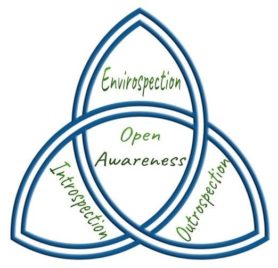
It is a curious paradox that the approach to a region which seems to us the way into utter darkness should yield the light of illumination as its fruit.
– Jung, C. G. (1969) p. 508
What those with burnout need are eyes that see in the dark, to have the darkness of their perception illuminated so that they can find their way again. This article highlights the value of- and the means to open the aperture of our awareness in order to illuminate the way through stress and burnout.
Cumulated stress, striving for unreachable goals, and ongoing dissatisfaction in our personal or professional relationships are some of the conditions known to lead to burnout. According to Wright (2010): Burnout is a form of deep human suffering at every level – physical, psychological, social, spiritual – which occurs when old ways of being in the world no longer work and start to disintegrate (p. 8). When one’s familiar ways of operating in one’s personal or professional life no longer get one the expected results or suddenly no longer fulfil one, such individuals may begin to feel empty or worthless, life loses meaning and dis-ease becomes one’s base-level state. Some people become so distressed that severe physical or mental illness or even suicide can result (Brühlmann, 2011).
Burnout is a type of soul sickness sometimes referred to as the dark night of the soul. Steve Taylor describes this phenomena as a phase where one’s inner light burns out, however it marks the imminent breakthrough to a new level of consciousness if it can be embraced (2011).
In my Treating Stress & Burnout – part 1 article I define two main types of burnout and both types can be metaphorically represented as being stuck in a gloomy tunnel with no end in sight. In this state we are cut off from our own inner resources and intuition. What seems to be concealed from the awareness of an individual who has burnout are the necessary resources to deal effectively with one’s situation. Therefore the way out of burnout, in addition to rest and rejuvenation, is suggested to be a means of being able to eliminate the effect of negative thoughts, as well as the ability to expand one’s perception of what is possible in such a situation, while developing receptivity to that which our inner wisdom reveals.
In the gloomy tunnel with no end in sight, tunnel vision is the only perception one has. This can be understood as a narrowed focus of attention that deletes from consciousness everything in the periphery of one’s field of awareness. The fight and flight (stress) response is correlated with being in tunnel vision, since we are required to identify only what the perceived danger is, thereby deleting whatever else is not necessary in our field of awareness in order to fight or flight in a life threatening situation. Similarly, in situations that are not threatening to our life, but considered by the individual to be unpleasant or disturbing, where one remains fixated on the object of negative reference, all other points of reference, including the quality of one’s own thoughts and feelings are negated (Drummond, D. n.d). Such is the case for those who experience overwhelming stress and burnout, whereby that which perpetuates the problem is what one’s attention remains focussed on, thus the problem remains a problem.
According to Bloom and Farragher (2010), tunnel vision is a narrowing of the perceptual field that results in difficulty to engage in complex thinking, to see interconnectedness or interrelationships between chunks of information. Learning and planning abilities are also impaired while we are in tunnel vision and experiencing stress. This is when we revert to automatic reactions and rules,- “Under stress, people tend to do what they know best rather than what would be best” (p. 109). The tunnel vision stress reaction reduces decision-making abilities, which become impulse, inflexible, poorly constructed and oversimplified (Janis, 1982). Tunnel vision constrains our creative thinking abilities and we become more dogmatic, focusing at best on solutions to problems that have worked in the past rather than finding something better suited to the results that we would like to achieve in our current situation (cited in Bloom and Farragher, 2010).
What people need in such circumstances is a way of transcending tunnel vision so that they can perceive other possibilities and identify different ways of dealing with the crisis. Assistance from others, inner guidance, or even ‘divine intervention’ may go unnoticed and be disregarded when one’s perceptual field is tightly narrowed on the object or thought that anchors the problem in its place. Opening the aperture of one’s perceptual awareness may be the key. Rick Hanson (2009) associates panoramic awareness with activation of the body’s parasympathetic nervous system (relaxation and ‘Alpha’ state), claiming that activation of the parasympathetic nervous system inhibits fight-flight stress reactions. Referring to brain scans from the Farb, et al. (2007) research, Hanson (2009) points out that panoramic awareness activates the brain’s lateral networks and facilitates the calm and relaxed sense of well-being that is typical of parasympathetic nervous system activation. Hanson also refers to panoramic awareness as having a “bird’s-eye-view” on a situation, in other words being able to disassociate from our thoughts in order to see things in a broader context. John Overdurf (2013) refers to peripheral vision as a synonym for Hanson’s panoramic awareness, and describes that peripheral vision acts on the brainstem and pre-frontal lobe, in effect short circuiting fear and stress reactions. Overdurf has been using peripheral vision in psychological interventions since the 1980s to help his patients “flatten out anxiety” (2013).
During my own training with Overdurf (2004 – 2010), we discovered first hand how techniques that activate open awareness work rapidly to reduce or even eliminate mental self talk and tension in the body. Since 2004 I have regularly used open awareness techniques in coaching and therapy with my own clients, as well as taught these techniques to many others at our courses. Applied open awareness has been found to be a consistently effective approach to calming the mind and body while opening one’s awareness to broader levels of perception in terms of external sensory acuity, as well as enhanced internal awareness of the quality of one’s own thoughts and emotions. Additionally, using advanced applications of applied open awareness, our clients and course participants report that this process can facilitate awareness of even more subtle realms of consciousness, where the boundaries between object and subject seem to dissolve and where a sense of unity and interconnectedness arises. It is becoming apparent that open awareness may serve as a bridge between the mental domain and transpersonal realms of consciousness. On this basis alone it is hypothesised that applied open awareness may be a useful resource to help alleviate overwhelming levels of stress or burnout, as well as issues that are associated with the concealment of consciousness, for example: anxiety, fear, anger, sadness, confusion, and guilt, as well as limited perceptions about oneself and one’s capabilities.
Burnout and the effects of stress are evidently outcomes of operating for too long in a state of tunnel vision. Applied open awareness is a practical approach that can help people to be more aware of their inner and outer resources. Anyone can learn how to open the aperture of their awareness in order to reveal more of their inherently enlightened state.
Written by Jevon Dangeli – NLP Trainer & Coach
.
>> How close are you to burnout? The Burnout Self Diagnostic Tool – free resource
.
>> Discover Jevon’s burnout prevention audio programme – Mindful Power
References:
Bloom, S. L. and Farragher, B. (2010) Destroying Sanctuary: The Crisis in Human Service Delivery Systems. New York: Oxford University Press, pp. 102-106.
Brühlmann, T. (2011). Open Forum at The World Economic Forum in Davos, Switzerland. Retrieved April 4, 2013, from the World Wide Web: http://www.youtube.com/watch? v=77Fy7kKHAfA
Drummond, D (n.d). Retrieved July, 3 2013, from the World Wide Web: http://www.accesstoinsight.org/tipitaka/mn/mn .010.than.html : http://www.thehappymd.com/pbp-vts-welcome/
Farb, N.A.S., Segal, Z.V., Mayberg, H., Bean, J., McKeon, D., Fatima, Z., and Anderson, A.K. (2007). Attending to the present: Mindfulness meditation reveals distinct neural modes of self-reflection. SCAN, 2, 313-322.
Hanson, R., & Mendius, R. (2009). Buddha’s brain: The practical neuroscience of happiness, love, and wisdom. New Harbinger Publications.
Hunt, T. (2007). “Dark Nights of the Soul”: Phenomenology and Neurocognition of Spiritual Suffering in Mysticism and Psychosis. The American Psychological AssociationReview of General Psychology. Vol. 11, No. 3.
Janis, I. L. (1982). Decision making under stress. Handbook Of Stress: Theoretical And Clinical Aspects. L. Goldberger and S. Breznitz. New York, Free Press,pp.69-87.
Jung, C. G. (1969). Psychological commentary on the Tibetan Book of the Great Liberation, in Collected Works, Vol. 11, Psychology and Religion: West and East, trans. R. F. C. Hull, second edition, Routledge & Kegan Paul (first published 1954).
Kabat-Zinn, J. (1990). Full catastrophe living. New York, NY: Delta Publishing.
Lancaster, B. L. (2004). Approaches to Consciousness: The Marriage of Science & Mysticism. Hampshire and New York: Palmgrave Macmillan.
Overdurf, J. Personal communication, June 20, 2013. http://www.johnoverdurf.com
Lancaster, B. L. (2005). The Essence of Kabbalah. Arcturus (UK) & Chartwell (US).
Taylor, S. (2011) Transformation Through Suffering : A Study of Individuals Who Have Experienced Positive Psychological Transformation Following Periods of Intense Turmoil. Journal of Humanistic Psychology. 52: 30
Tolle, E. (1999). The power of now: A guide to spiritual enlightenment. Novato, CA: Namaste.
Wright, S. (2010). Burnout, a spiritual crisis on the Way Home. Cumbria. Sacred Space Publications (p. 8).
